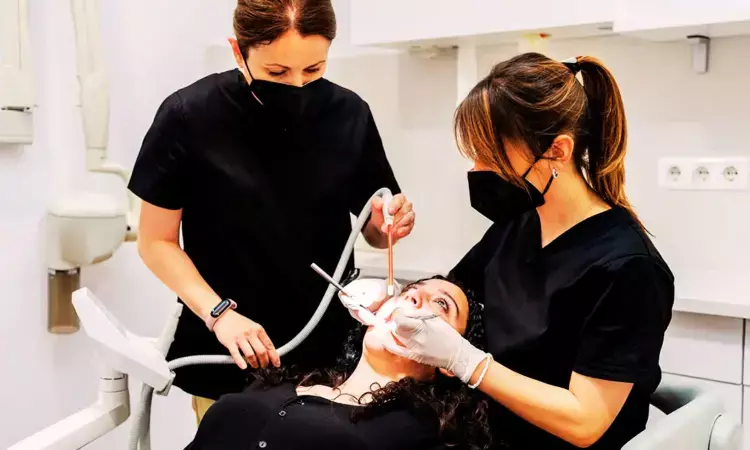- Home
- Medical news & Guidelines
- Anesthesiology
- Cardiology and CTVS
- Critical Care
- Dentistry
- Dermatology
- Diabetes and Endocrinology
- ENT
- Gastroenterology
- Medicine
- Nephrology
- Neurology
- Obstretics-Gynaecology
- Oncology
- Ophthalmology
- Orthopaedics
- Pediatrics-Neonatology
- Psychiatry
- Pulmonology
- Radiology
- Surgery
- Urology
- Laboratory Medicine
- Diet
- Nursing
- Paramedical
- Physiotherapy
- Health news
- Fact Check
- Bone Health Fact Check
- Brain Health Fact Check
- Cancer Related Fact Check
- Child Care Fact Check
- Dental and oral health fact check
- Diabetes and metabolic health fact check
- Diet and Nutrition Fact Check
- Eye and ENT Care Fact Check
- Fitness fact check
- Gut health fact check
- Heart health fact check
- Kidney health fact check
- Medical education fact check
- Men's health fact check
- Respiratory fact check
- Skin and hair care fact check
- Vaccine and Immunization fact check
- Women's health fact check
- AYUSH
- State News
- Andaman and Nicobar Islands
- Andhra Pradesh
- Arunachal Pradesh
- Assam
- Bihar
- Chandigarh
- Chattisgarh
- Dadra and Nagar Haveli
- Daman and Diu
- Delhi
- Goa
- Gujarat
- Haryana
- Himachal Pradesh
- Jammu & Kashmir
- Jharkhand
- Karnataka
- Kerala
- Ladakh
- Lakshadweep
- Madhya Pradesh
- Maharashtra
- Manipur
- Meghalaya
- Mizoram
- Nagaland
- Odisha
- Puducherry
- Punjab
- Rajasthan
- Sikkim
- Tamil Nadu
- Telangana
- Tripura
- Uttar Pradesh
- Uttrakhand
- West Bengal
- Medical Education
- Industry
Pulp Capping Success Linked to Material Choice, Patient Age, and Adhesive Systems: New Study Reveals

Italy: A new retrospective clinical study sheds light on the effectiveness of direct and indirect pulp capping techniques in preserving dental pulp vitality over the long term.
The study, published in the Journal of Clinical Medicine, revealed that the success of preserving pulp vitality following indirect pulp capping treatments is influenced by the type of adhesive system employed, with the total-etch system demonstrating superior performance compared to the self-etch system.
"When performing direct pulp-capping treatments, it is crucial to carefully consider the type of pulp-capping material, the patient’s age, and the extent of pulp exposure before the procedure," the researchers wrote.
The research highlights that direct and indirect pulp capping procedures are pivotal in maintaining dental pulp health when faced with exposure or deep carious lesions. Mario Alovisi, Department of Surgical Sciences, Dental School, University of Turin, Turin, Italy, and colleagues sought to evaluate the long-term reactions of dental pulp tissue to direct and indirect pulp capping treatments after a 10-year follow-up period.
For this purpose, the researchers evaluated 276 permanent teeth with deep carious lesions, categorizing them into five distinct groups: Group 1 received direct pulp capping using Mineral Trioxide Aggregate cement; Group 2 was treated with direct pulp capping using a resin-based glass ionomer; Group 3 involved direct pulp capping with TheraCal; Group 4 underwent indirect pulp capping with a three-step total-etch adhesive system; and Group 5 was treated with indirect pulp capping using a two-step self-etch adhesive system.
The following were the key findings of the study:
- A 72.5% success rate was achieved overall.
- There was a statistically significant difference when comparing direct and indirect pulp capping with a success rate of 23.8% and 93.8%, respectively.
- For direct pulp-capping procedures, the area of pulp exposure was correlated with pulp necrosis, while bleeding after exposure appeared independent.
- Patient age was significantly related to the maintenance of pulp vitality.
- A statistically significant correlation between the pulp-capping material and the occurrence of pulp necrosis was discovered.
- For the indirect pulp-capping treatments, a significant correlation between patient age and the adhesive system with pulp necrosis was described.
This retrospective study highlighted the importance of carefully selecting the pulp-capping material for direct capping procedures. It also revealed that factors such as patient age and the extent of pulp exposure significantly impact the preservation of pulp vitality.
"Furthermore, the study found that the success of indirect pulp-capping treatments in maintaining pulp vitality is influenced by the adhesive system used, with the total-etch system proving more effective than the self-etch system," the researchers concluded.
Reference:
Alovisi, M., Baldi, A., Comba, A., Gamerro, R., Paolone, G., Mandurino, M., Dioguardi, M., Roggia, A., & Scotti, N. (2023). Long-Term Evaluation of Pulp Vitality Preservation in Direct and Indirect Pulp Capping: A Retrospective Clinical Study. Journal of Clinical Medicine, 13(13), 3962. https://doi.org/10.3390/jcm13133962
Dr Kamal Kant Kohli-MBBS, DTCD- a chest specialist with more than 30 years of practice and a flair for writing clinical articles, Dr Kamal Kant Kohli joined Medical Dialogues as a Chief Editor of Medical News. Besides writing articles, as an editor, he proofreads and verifies all the medical content published on Medical Dialogues including those coming from journals, studies,medical conferences,guidelines etc. Email: drkohli@medicaldialogues.in. Contact no. 011-43720751


